I'm building a simple application using WPF and GalaSoft MvvmLight (5.4.1.1).
Everything works fine, I have a grid, and when a row is selected I enable/disable buttons that have actions assigned.
Sample button looks like that:
<Button Command="{Binding MarkRouteAsCompletedCommand, Mode=OneTime}">Mak as Completed</Button>
When I change the Button to my UserControl I don't get the "enable/disable" effect and my custom control is always enabled.
I've created a UserControl that looks like this (two controls shown):
The XAML for them looks like this:
<controls:ShortcutButton Text="Create" Command="{Binding CreateCommand, Mode=OneTime}" Shortcut="Insert"/>
<controls:ShortcutButton Text="Edit" Command="{Binding EditCommand, Mode=OneTime}" Shortcut="F2"/>
The idea was to display the keyboard key that is assigned to a specific button.
My UserControl looks like this:
XAML:
<UserControl x:Class="ABC.Desktop.Wpf.Controls.Buttons.ShortcutButton"
xmlns="http://schemas.microsoft.com/winfx/2006/xaml/presentation"
xmlns:x="http://schemas.microsoft.com/winfx/2006/xaml"
xmlns:mc="http://schemas.openxmlformats.org/markup-compatibility/2006"
xmlns:d="http://schemas.microsoft.com/expression/blend/2008"
mc:Ignorable="d"
d:DesignHeight="450" d:DesignWidth="800">
<StackPanel>
<TextBlock Margin="3,0,3,0" FontSize="10" Text="{Binding Shortcut, Mode=OneWay, Converter={StaticResource ObjectToStringConverter}, RelativeSource={RelativeSource Mode=FindAncestor, AncestorType={x:Type UserControl}}}"/>
<Button MinWidth="80"
Content="{Binding Text, Mode=OneWay, RelativeSource={RelativeSource Mode=FindAncestor, AncestorType={x:Type UserControl}}}"
IsCancel="{Binding IsCancel, Mode=OneWay, RelativeSource={RelativeSource Mode=FindAncestor, AncestorType={x:Type UserControl}}}">
<Button.InputBindings>
<MouseBinding Gesture="LeftClick" Command="{Binding Command, Mode=OneWay, RelativeSource={RelativeSource Mode=FindAncestor, AncestorType={x:Type UserControl}}}"
CommandParameter="{Binding CommandParameter, Mode=OneWay, RelativeSource={RelativeSource Mode=FindAncestor, AncestorType={x:Type UserControl}}}"/>
</Button.InputBindings>
</Button>
</StackPanel>
</UserControl>
Code behind:
using System.Windows;
using System.Windows.Controls;
using System.Windows.Input;
namespace ABC.Desktop.Wpf.Controls.Buttons
{
public partial class ShortcutButton : UserControl
{
public static readonly DependencyProperty TextProperty = DependencyProperty.Register(nameof(Text), typeof(string), typeof(ShortcutButton), new PropertyMetadata(null));
public static readonly DependencyProperty CommandProperty = DependencyProperty.Register(nameof(Command), typeof(ICommand), typeof(ShortcutButton), new PropertyMetadata(null));
public static readonly DependencyProperty CommandParameterProperty = DependencyProperty.Register(nameof(CommandParameter), typeof(object), typeof(ShortcutButton), new PropertyMetadata(null));
public ShortcutButton()
{
InitializeComponent();
}
public Key? Shortcut { get; set; }
public bool IsCancel { get; set; }
public string Text
{
get => (string)GetValue(TextProperty);
set => SetValue(TextProperty, value);
}
public ICommand Command
{
get => (ICommand)GetValue(CommandProperty);
set => SetValue(CommandProperty, value);
}
public object CommandParameter
{
get => GetValue(CommandParameterProperty);
set => SetValue(CommandParameterProperty, value);
}
}
}
I have no idea why enabling/disabling works with Button but not with my UserControl. Probably I must implement something in my UserControl, but I have not a clue what.
